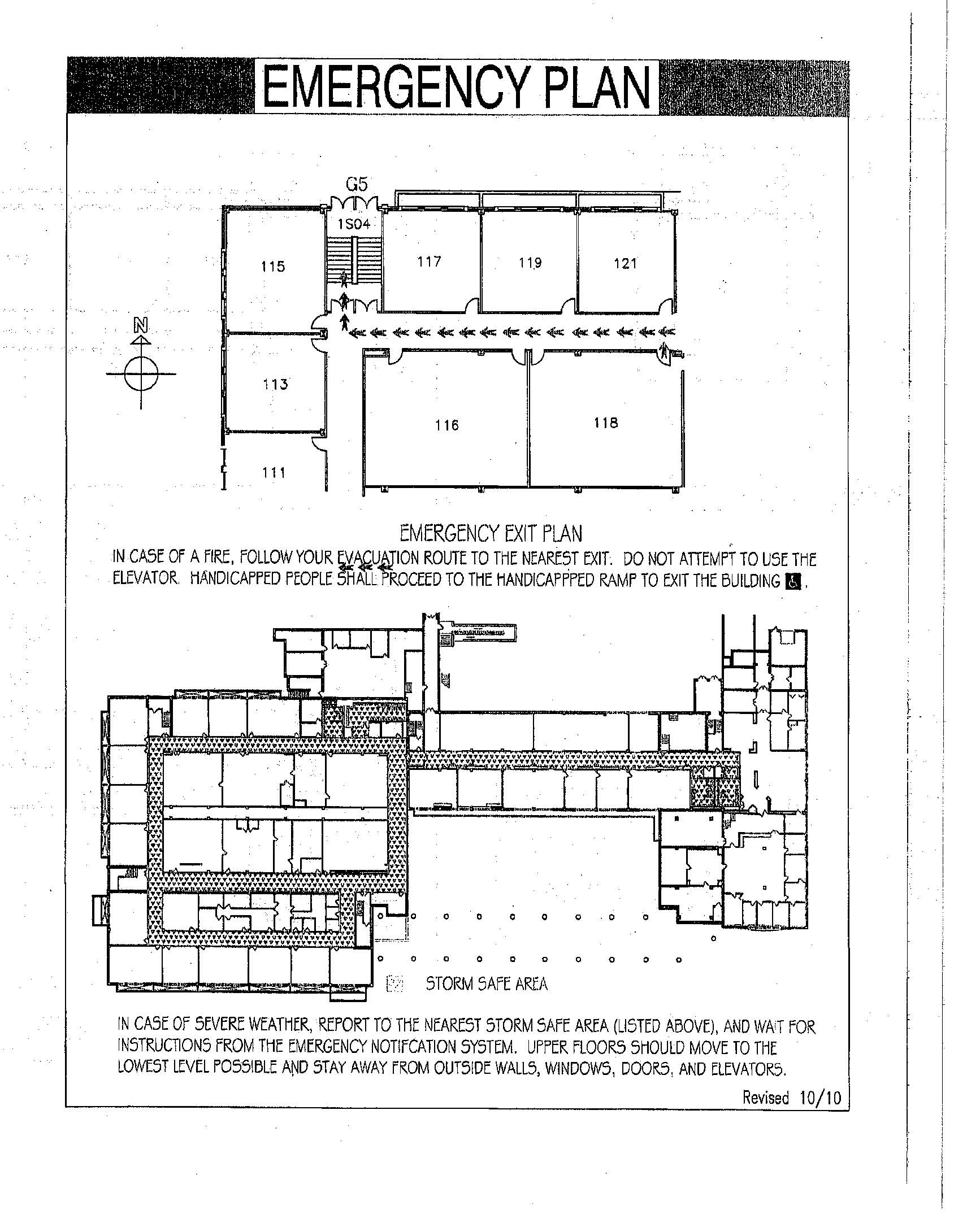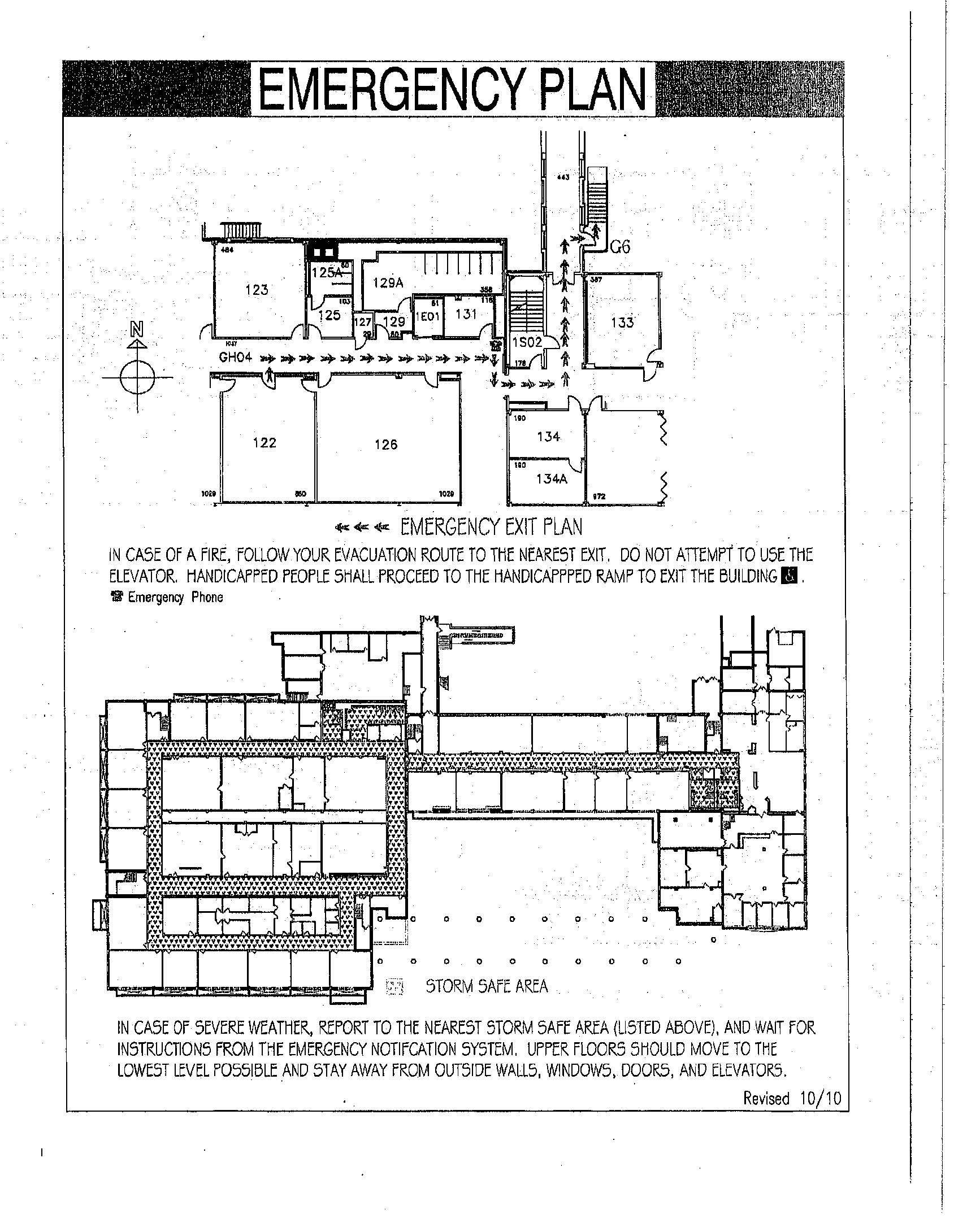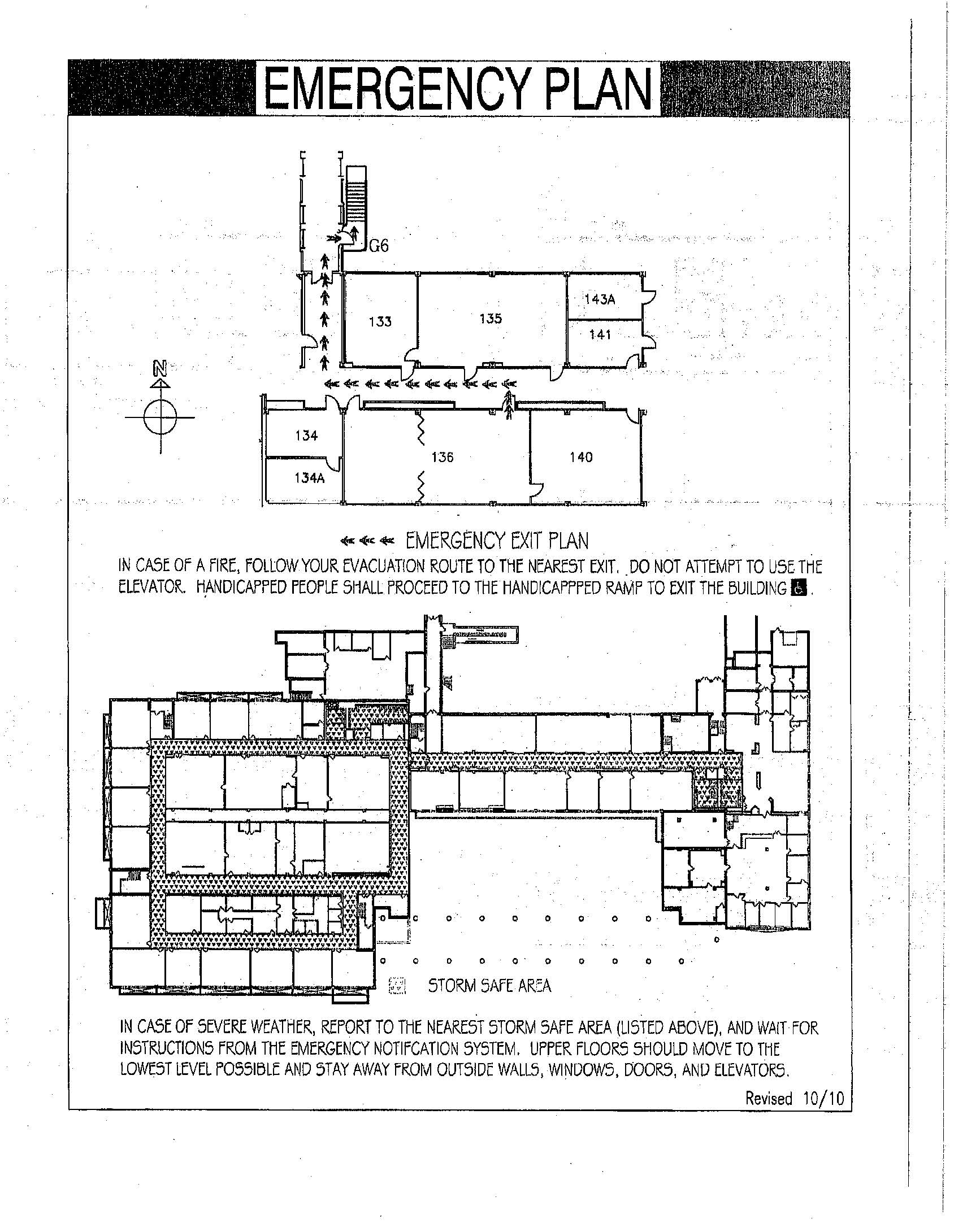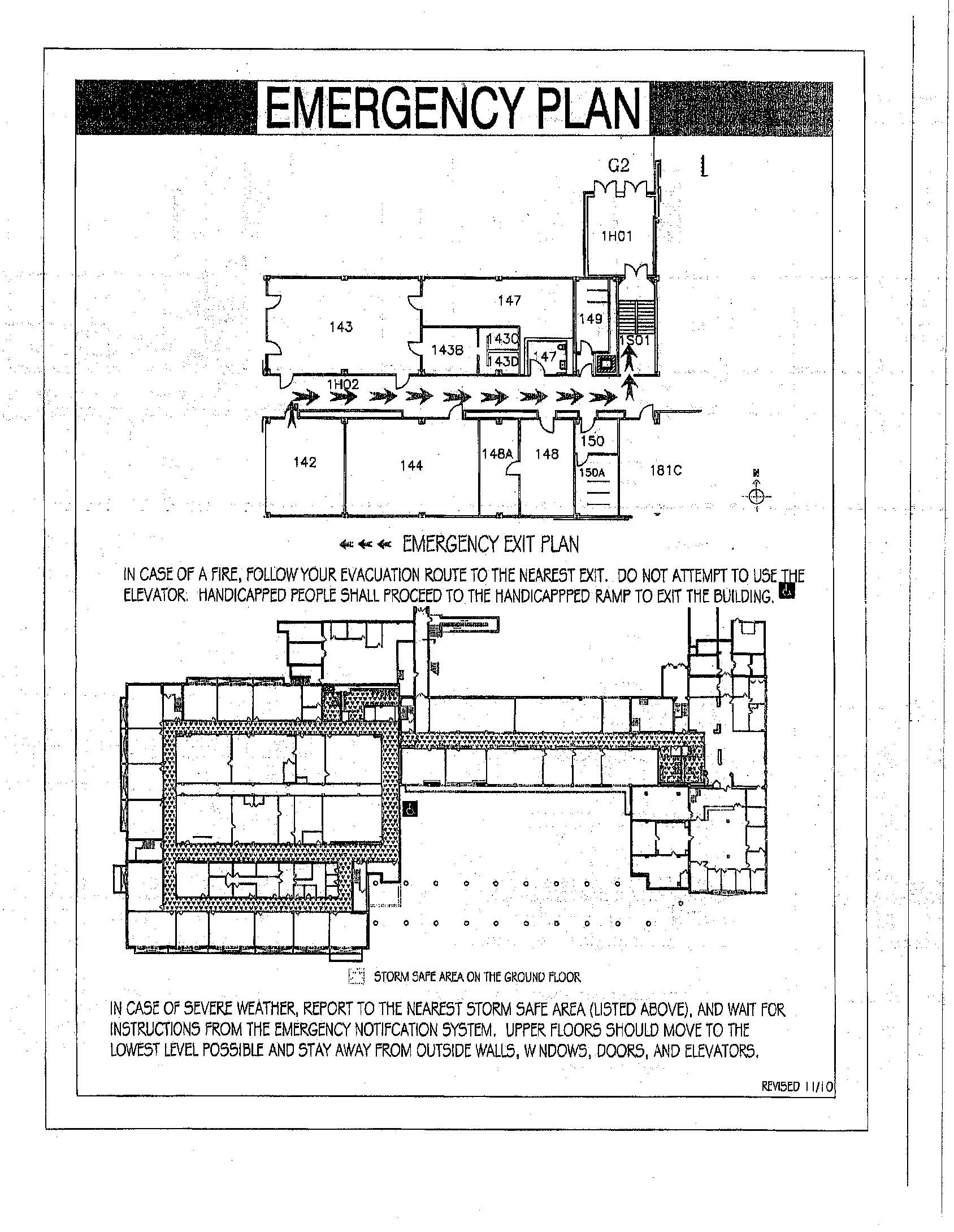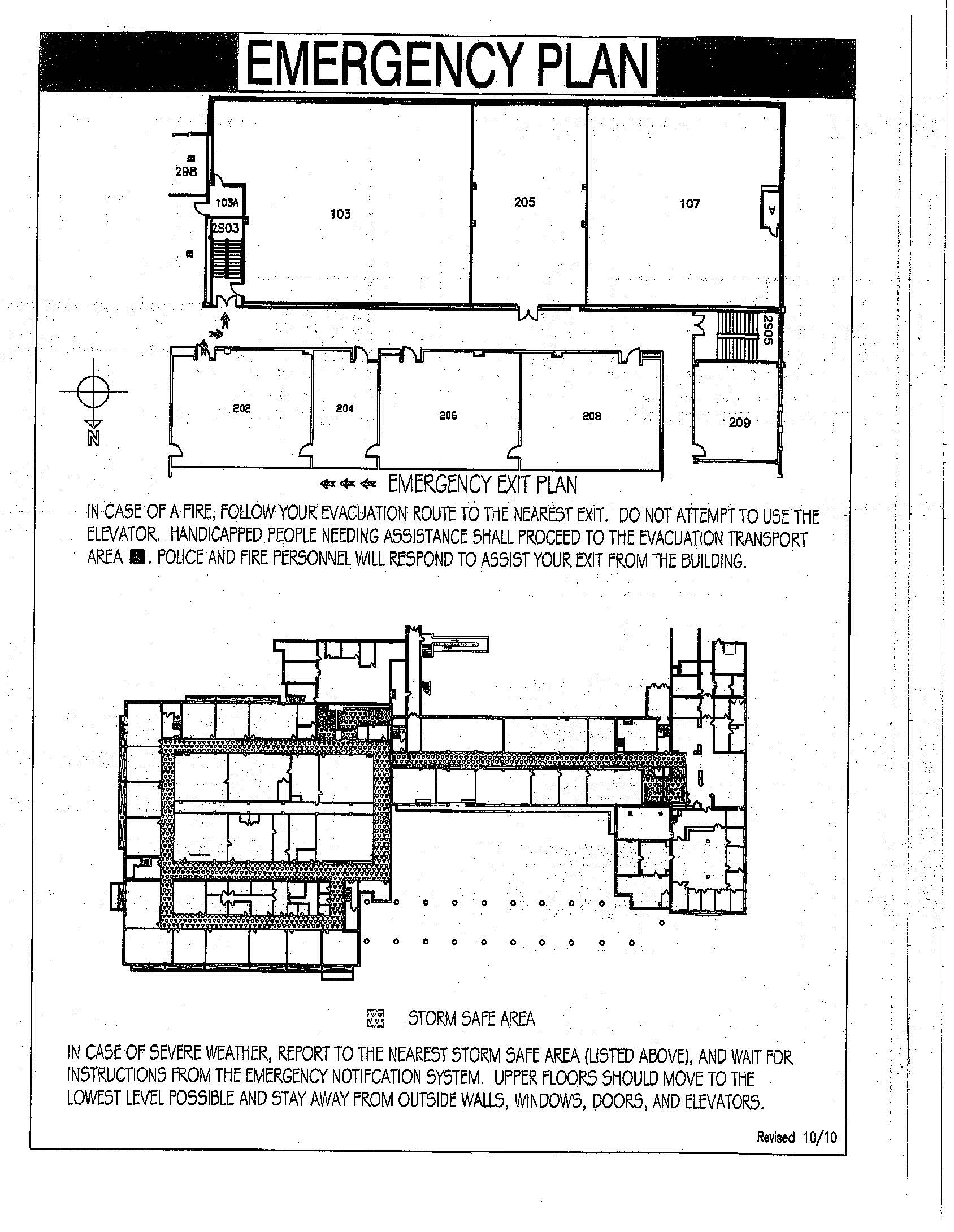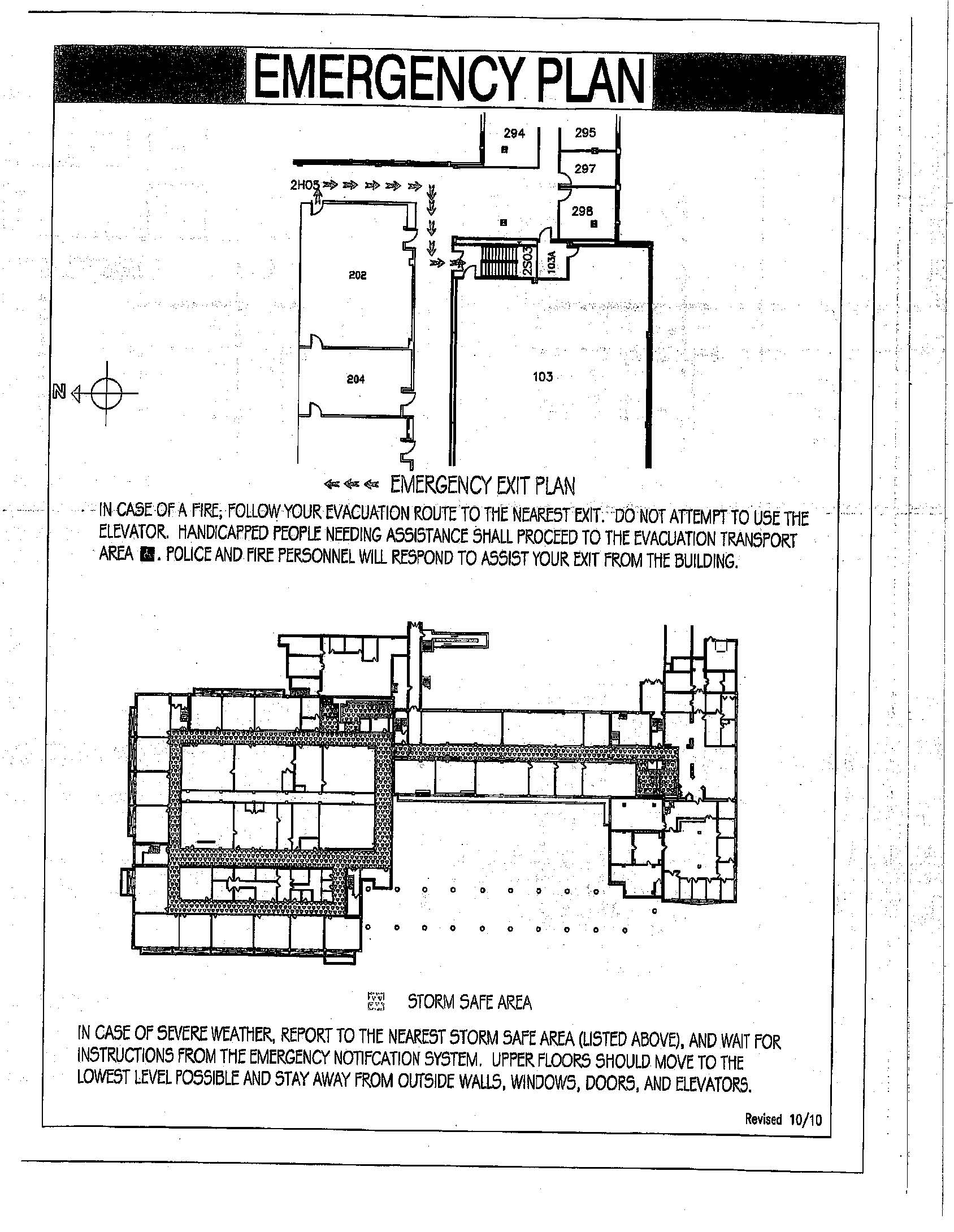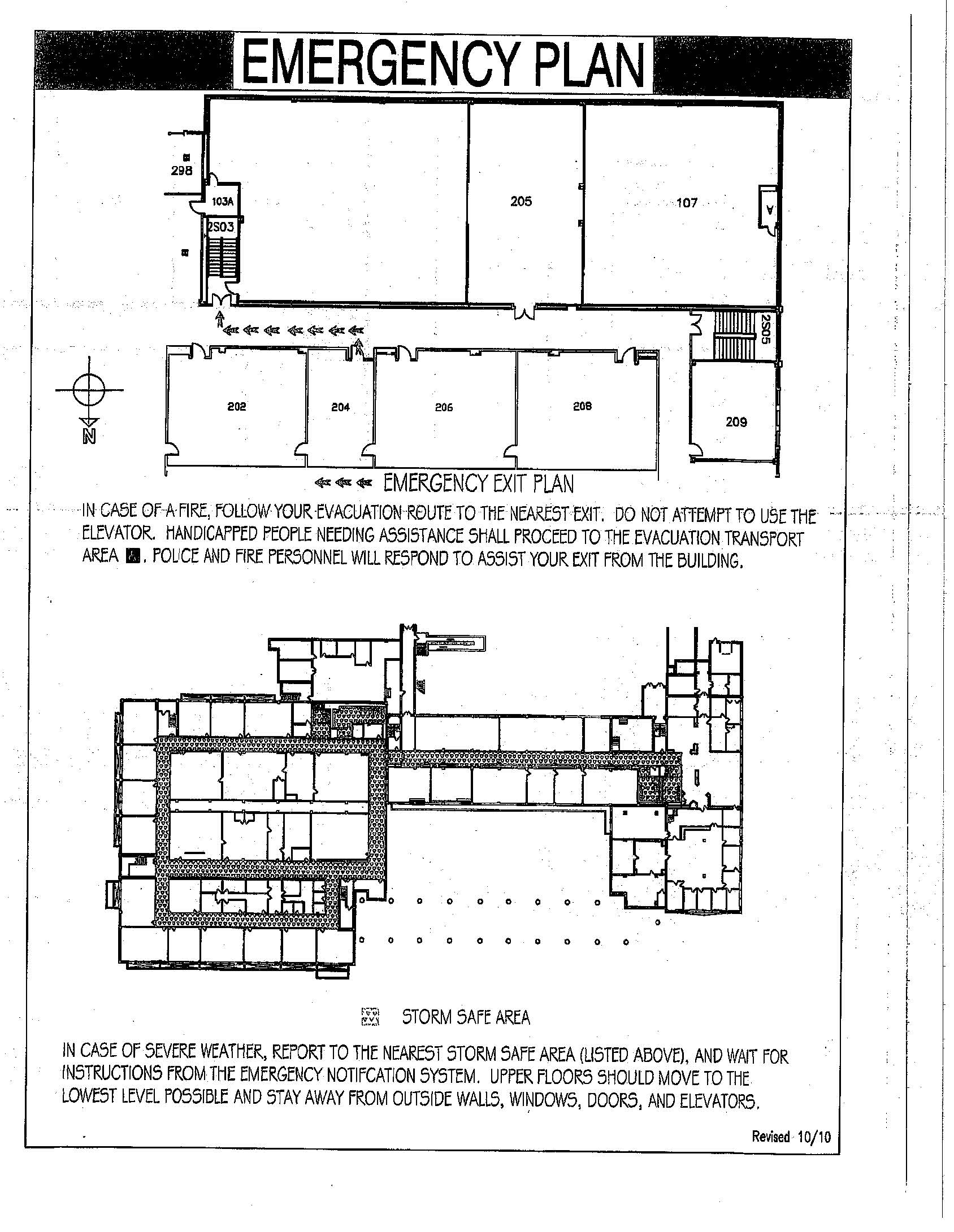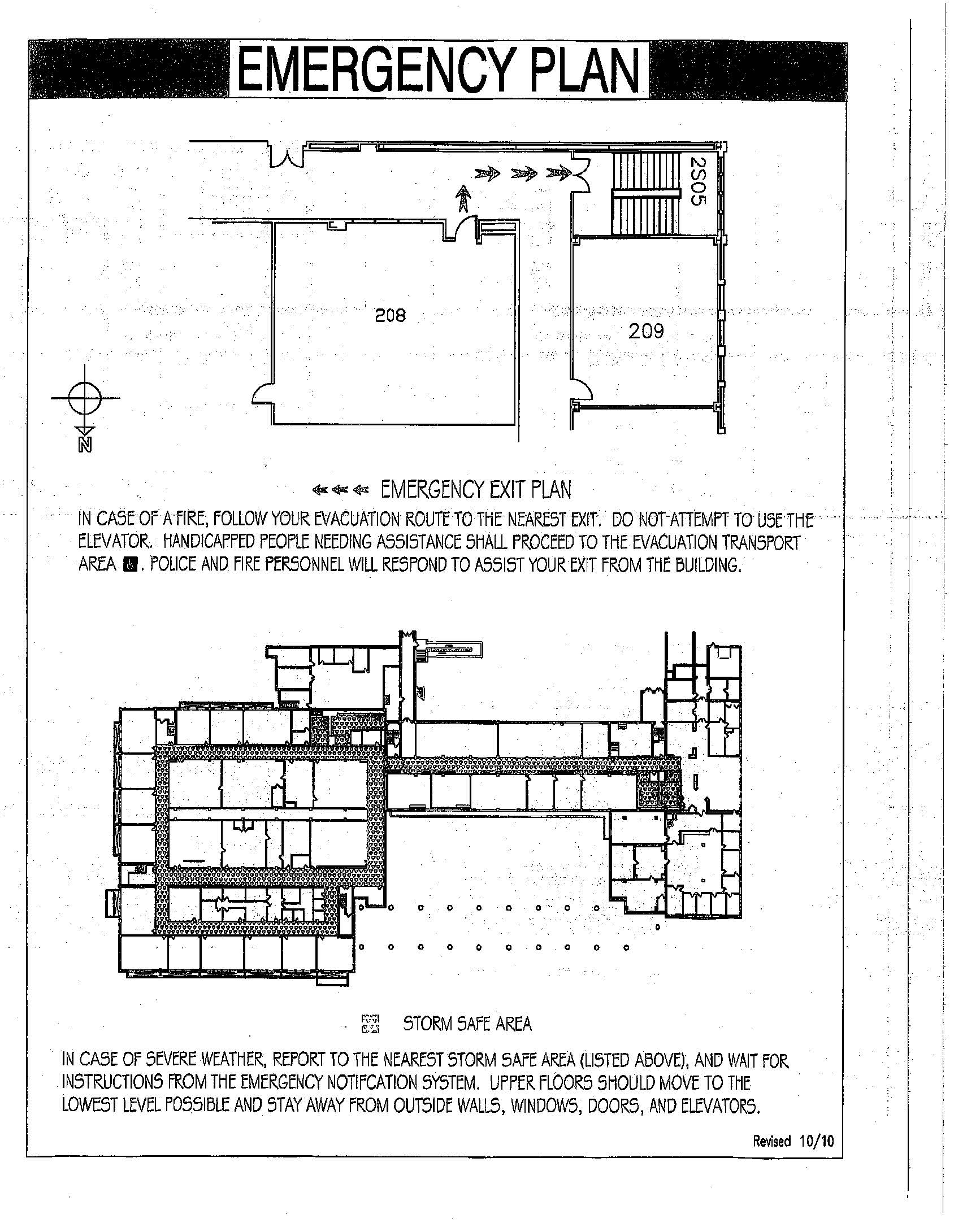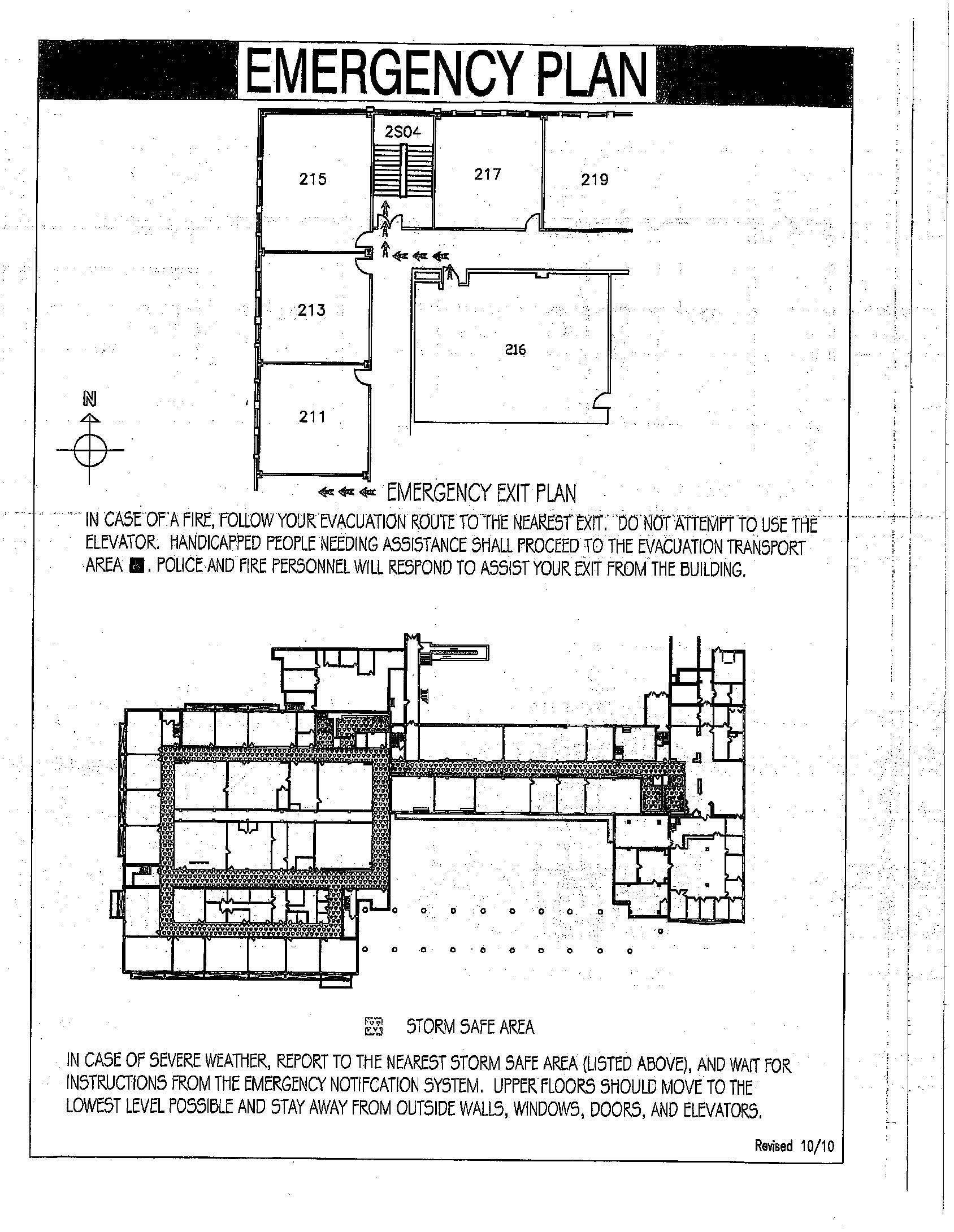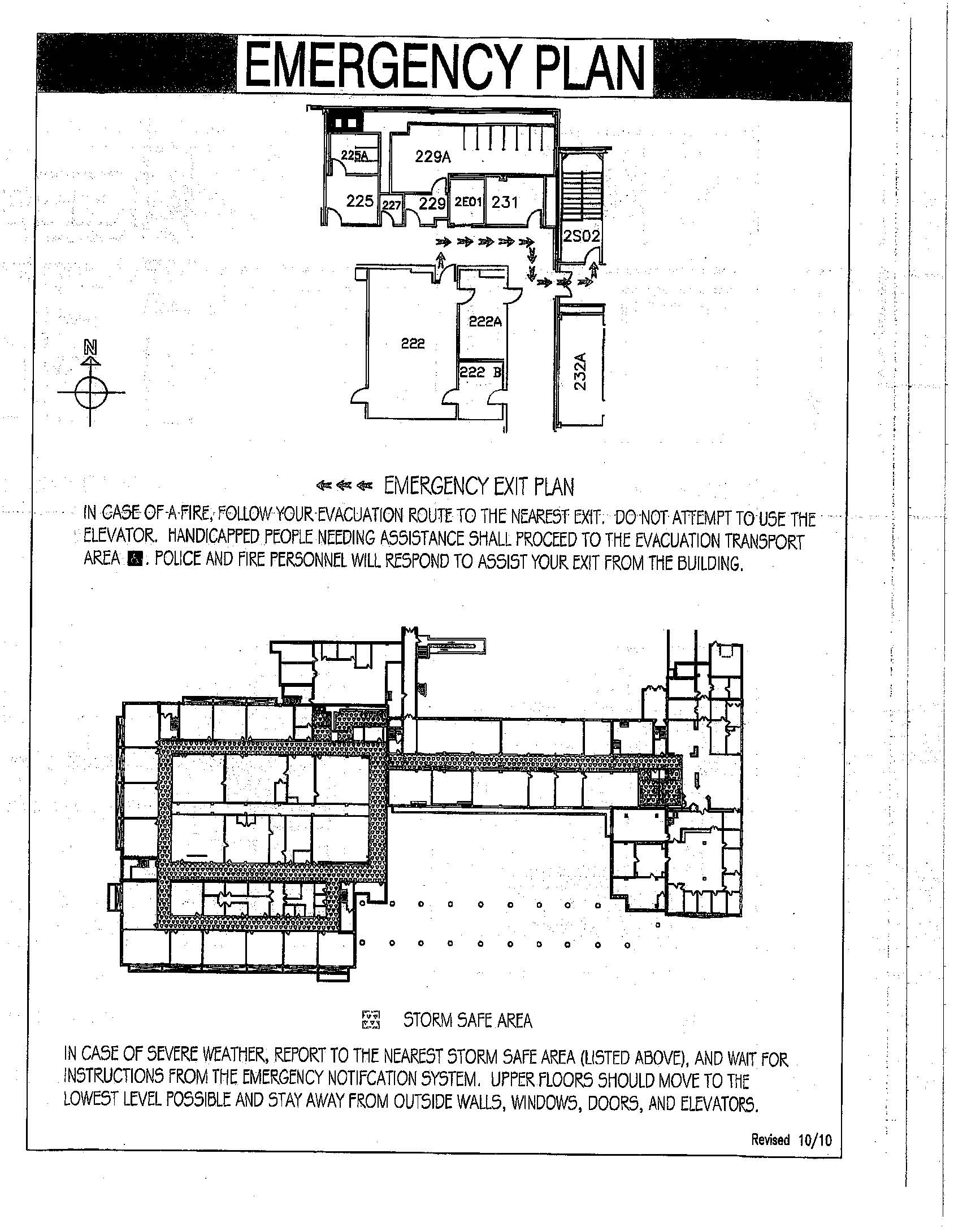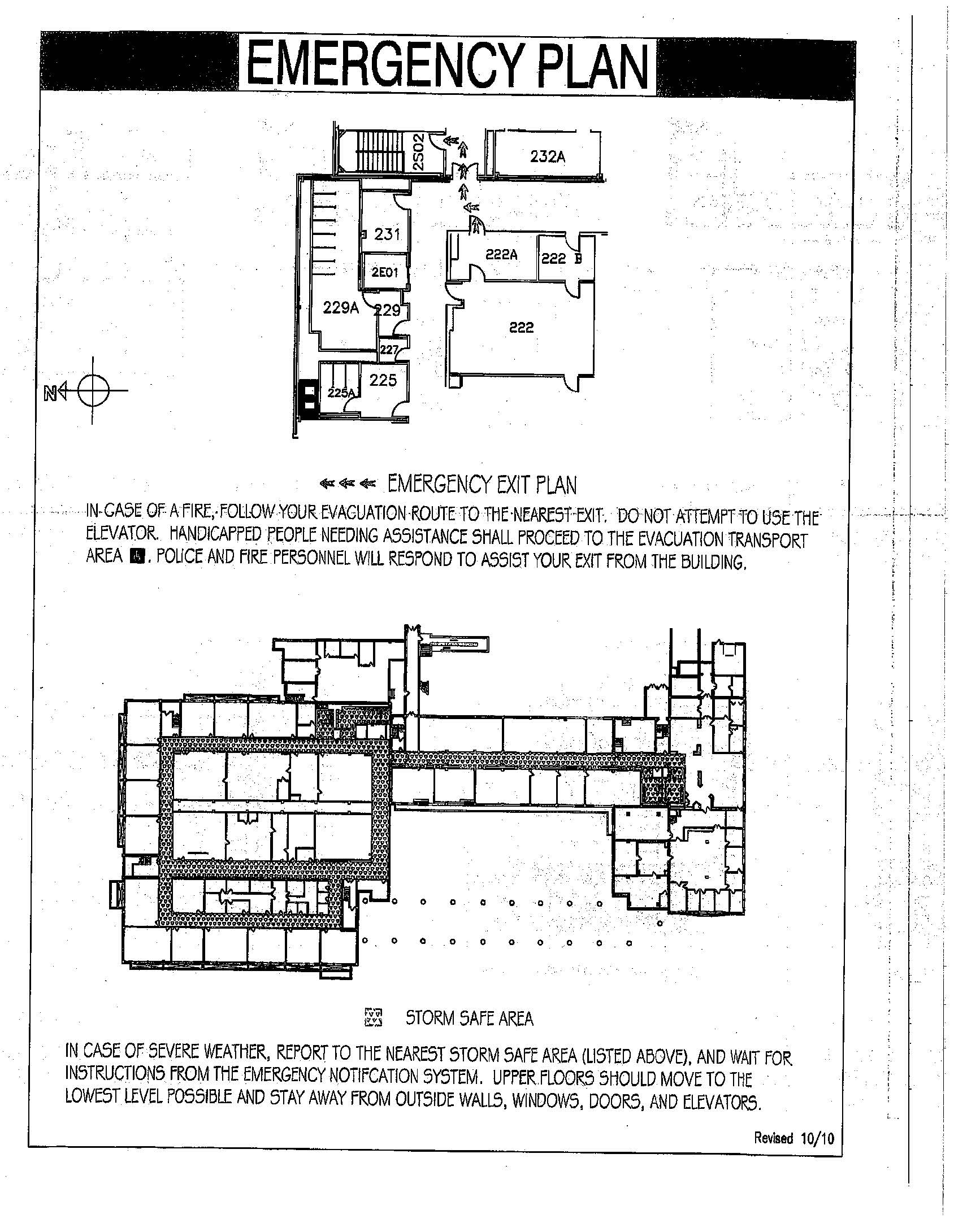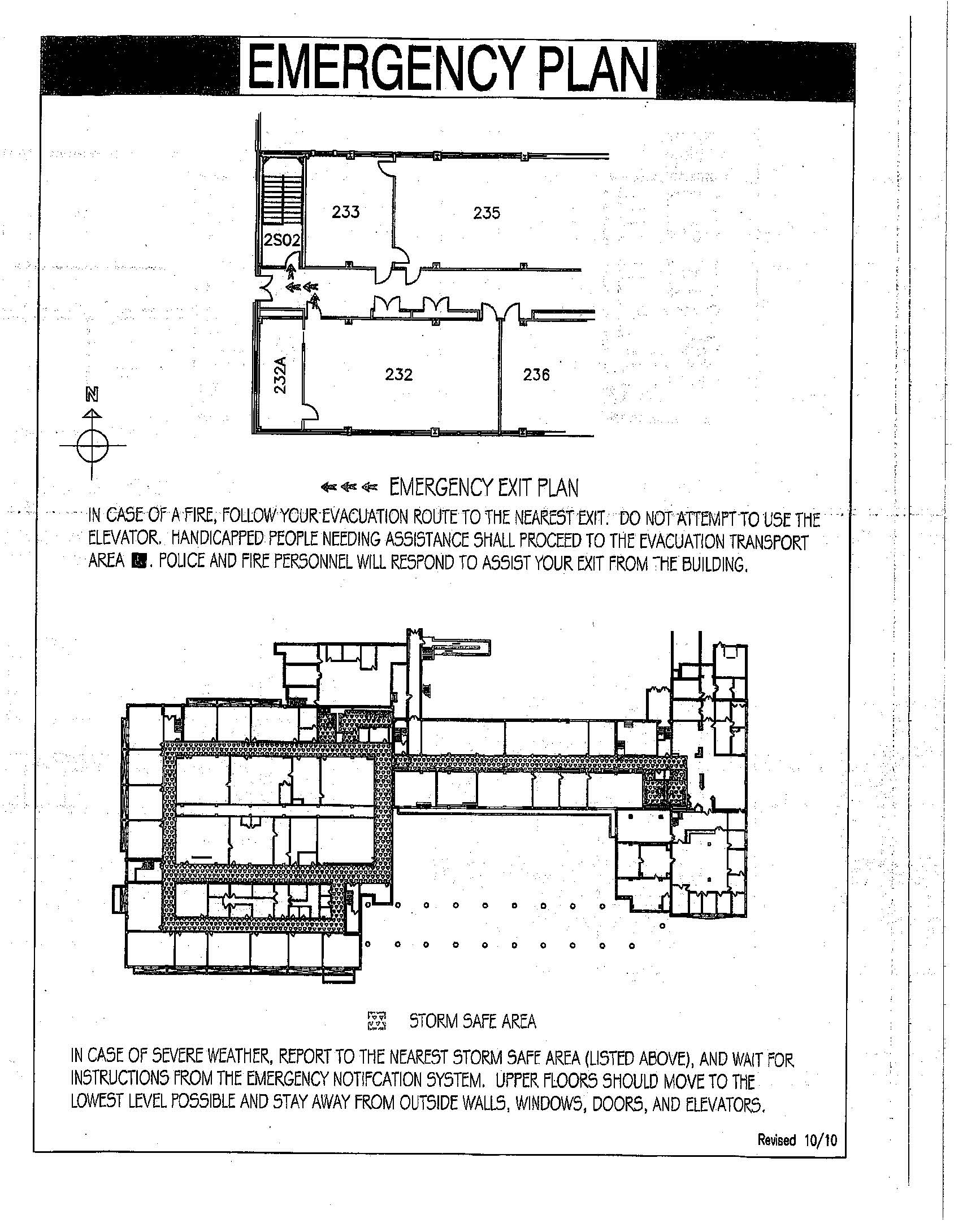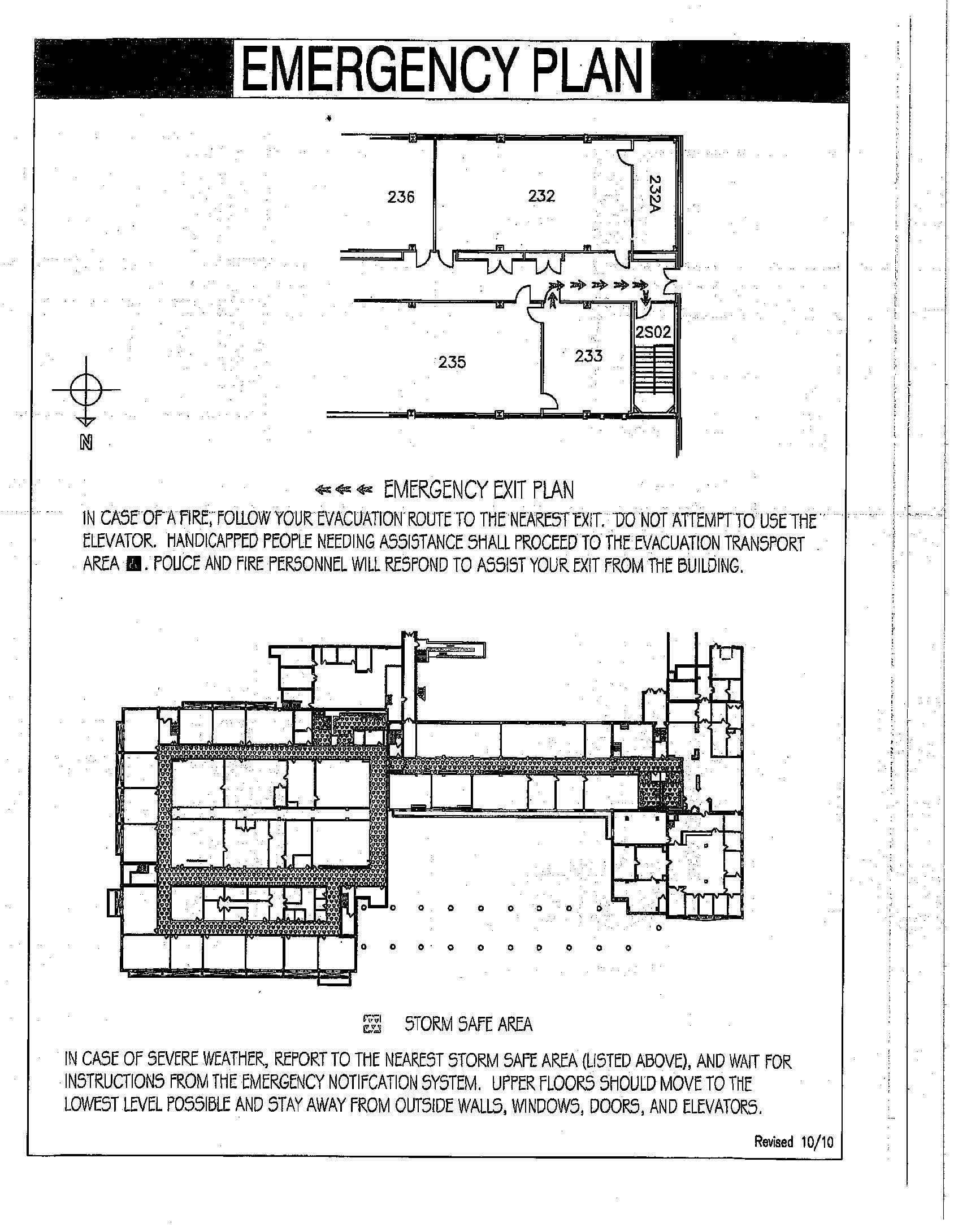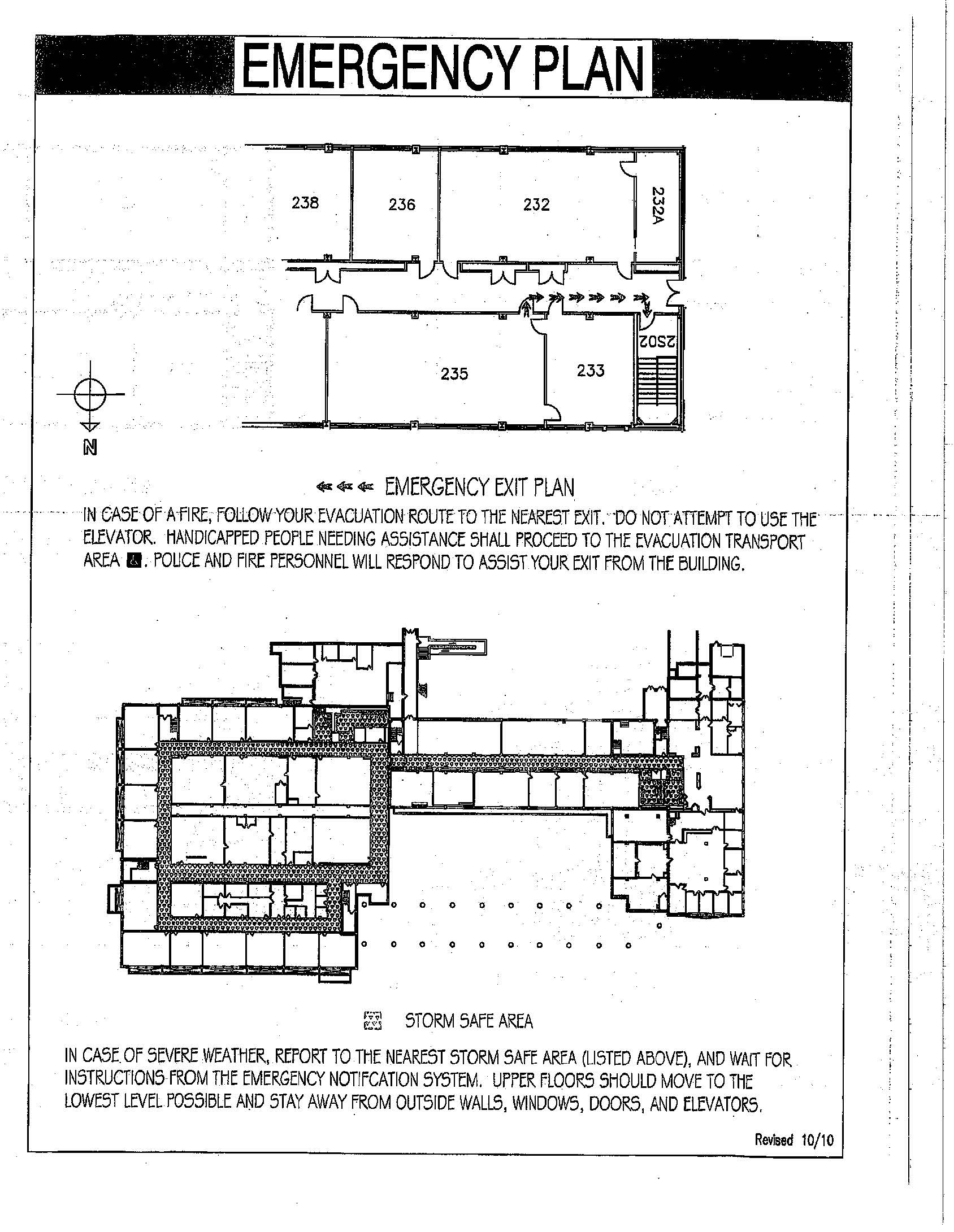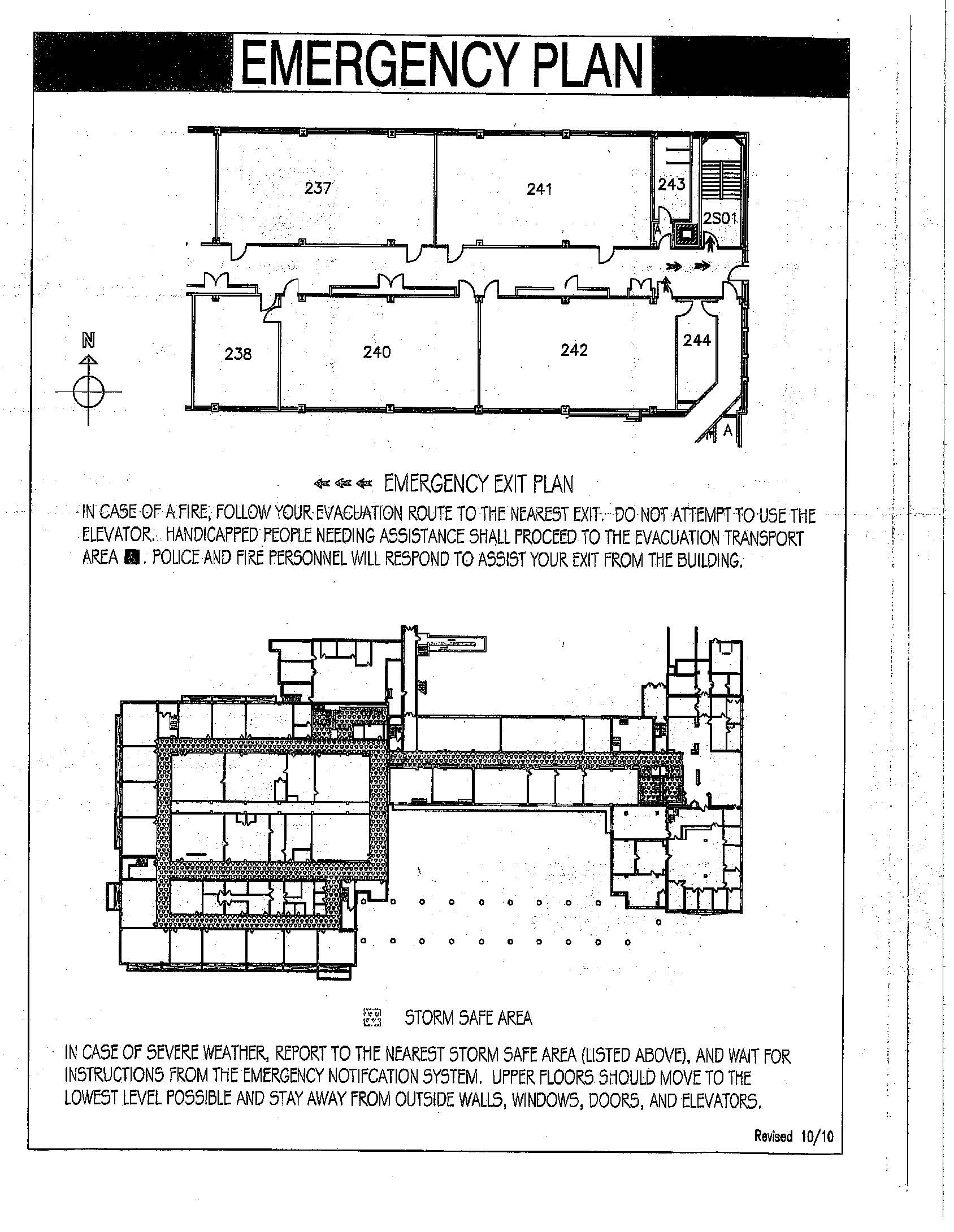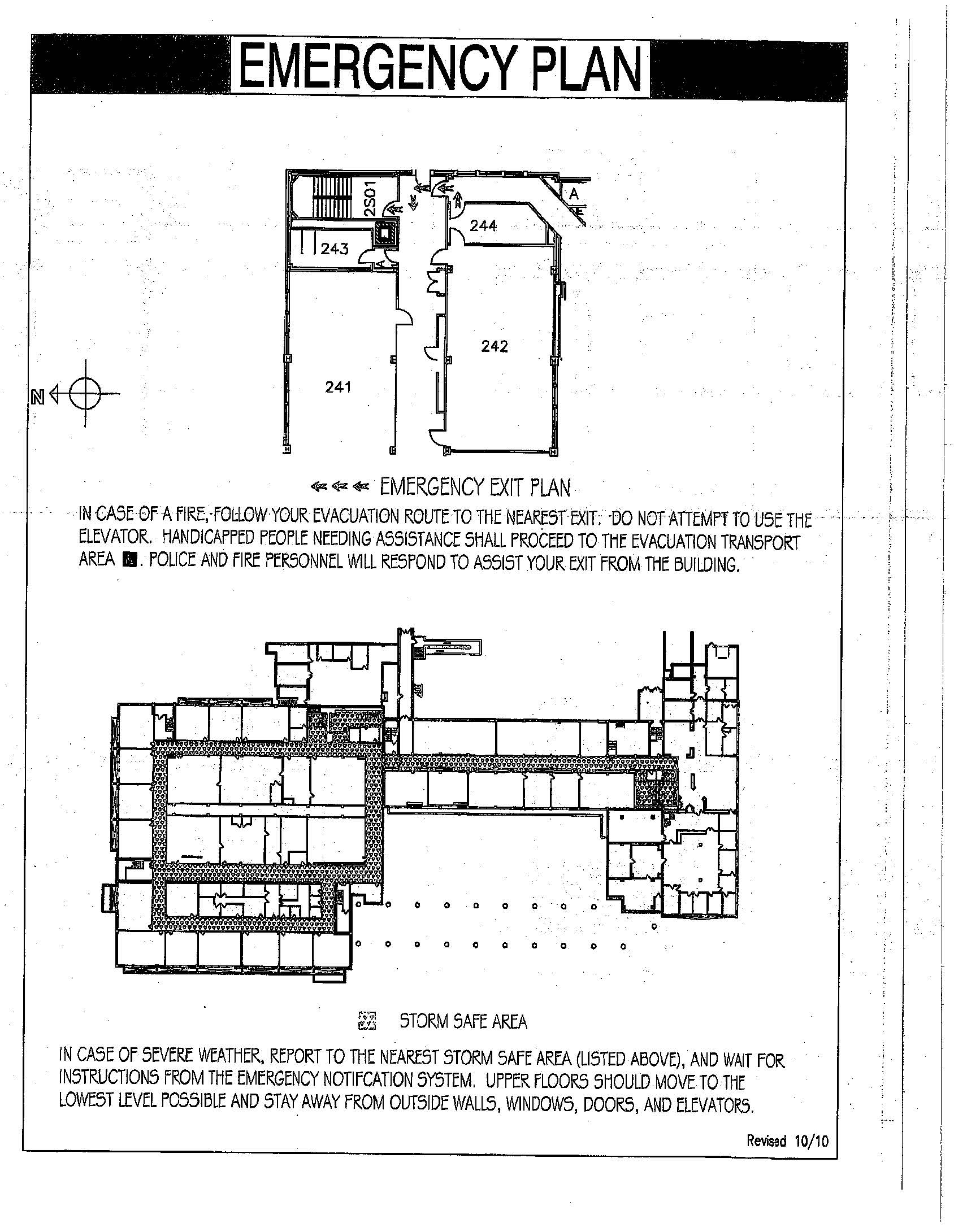Gyte Labs Emergency Plan
Gyte Building Chemistry / Physics Laboratories
(2200 169th Street, Hammond, Indiana 46323)
Laboratory Emergency Plan

QUICK REFERENCE SUMMARY
Building Deputy Name:
Phone #
Evacuation Emergency Assembly Areas (fire alarm): Southeast side of Building in Founder’s Plaza next to Emergency Blue Light.
Shelter in Place requirement for a tornado warning: Basement/hallway without windows.
Shelter in Place requirement for a civil disturbance such as a shooting: If one cannot get away, shelter in a room that is securable preferably without windows.
Shelter in Place requirement for a major hazardous materials release: shelter in nearest building or classroom, shutting any open doors and windows.
NOTE: In-depth information, procedures, and considerations are detailed on the following pages. This summary provides the evacuation and shelter locations for various incidents. Everyone should read and understand the entire BEP at least once per year. Please contact the Department of Public Safety Office at 989-2994 if you have any questions. You may also contact Building Deputy/CERT TEAM members James Lesniak 219 989-2321 or Michael Pelter 219 989-2449.
Get Ready…Get Set…Go
Shelter in Place Considerations for Life Threatening Incidents
| This information is designed to encourage building occupants to develop an individual plan based on potential life threatening incidents such as a shooting on campus. Actions should be based on situational awareness. React to PNW ALERT information as well as what you see and hear in your general area. See EP website for more information. |
||
| Get Ready…be prepared.
A life threatening incident has occurred on the Northwest (Hammond) campus; incident location is not near me. |
General Actions:
|
Specific actions based on your location:
|
| Get Set…stay alert; be prepared to implement your plan.
A life threatening incident has occurred on the Purdue University Northwest (Hammond) campus; incident location is near me but not in my building. |
|
|
| Go…stay calm and activate your plan.
A life threatening incident has occurred on the Purdue University Northwest (Hammond) campus; incident location is in my building or I feel my safety is in jeopardy (location of perpetrator is unknown). |
Based on situational awareness, immediately:
|
|
Section 1: User Items
1.1 Emergency Contact Information:
A) Building Deputy or designated BEP developer
Name: James Lesniak
Phone Number: 219 989-2321
Email Address: jrlesnia@pnw.edu
Office/Room Number: Gyte 222B
After Hours Emergency Contact Number, if applicable: Brian Miller (219) 712-0178
1.2 Non-emergency Contact Numbers:
- Hammond Fire Department — 853-6418
- Purdue University Northwest Police Department — 989-2140
- Radiological and Environmental Management — 989-2724
- Physical Facilities Services — 989-2285
- Department of Public Safety — 989-2994
1.3 Automatic External Defibrillator (AED)
- Many departments have purchased AED (s) and placed them in locations throughout their building. If your facility has an AED (s), please fill out the following table:
AED Location Contact Person Contact Person’s Phone # Gyte Annex, East Side of the Building Adjacent to Health Services Brian Miller (219) 989-2994 - For any questions about AED’s or to report a purchase of one, please contact Director Brian Miller with Department of Public Safety at 989-2994.
1.4 Response to Alarms:
REMEMBER, WHEN YOU HEAR:
- ALL HAZARDS OUTDOOR WARNING SIRENS immediately seek shelter (Shelter-In-Place) in a safe location within closest facility
- FIRE ALARMS immediately evacuate the building and move to a safe location
In both cases, you should seek additional clarifying information by all possible means…text, Twitter, email, Purdue Homepage, TV, radio, etc.
1.5 Emergency Evacuation
- General Evacuation Procedures–If you hear the fire alarm or are instructed to leave the building:
- You must immediately obey evacuation alarms and orders. Tell others to evacuate.
- No one may remain inside a building when an evacuation is in progress.
- Classes in session must evacuate.
- If involved with hazardous research or doing a dangerous procedure, immediately shut down operations that could create additional hazards if left unattended. Evacuate as soon as possible.
- When you evacuate, take keys, coat, purse and any other critical personal items with you to the EAA. REMEMBER, IN CASE OF A FIRE, IT IS IMPORTANT TO NOT DELAY EVACUATION.
- Close doors as rooms are vacated.
- Assist those who need help, but do not put yourself at risk attempting to rescue trapped or injured victims.
- Note location of trapped and injured victims and notify emergency responders.
- Walk calmly but quickly to the nearest emergency exit.
- Use stairways only. Do not use elevators.
- Keep to the right side of corridors and stairwells as you exit.
- Proceed directly to your designated EAA. Stay away from the immediate area near the building you evacuated.
- Remain in EAA until roll is taken and instructions are given.
- Do not reenter the building until authorized fire or police department personnel give the “All Clear” instruction.
- Building Specific Evacuation Procedures
Evacuation procedures must take into account any specific building and occupant needs. (Add maps, exit routes, other steps, actions, or precautions specific to your building or work area.) - Emergency Assembly Area Location – Southeast side of Gyte Building Founders’ Plaza (after you have evacuated your building)
- Determine an Emergency Assembly Area (EAA—roll call/head count area) away from the building and in a location that will not interfere with emergency personnel. Do your best to implement personnel accounting procedures IE. “Sign In Sheet” for labs. However, it is understood that many facilities (especially academic buildings) have incoming and outgoing students, faculty, staff, and visitors which makes a “headcount” very difficult to conduct. The Building Deputy/CERT Team Member or representative should provide first responder personnel as much information as you know. Provide this information to Incident Command, Command 14 (PUFD command vehicle), or the nearest public safety official as soon as possible.
- Primary location should be outside, in an area away from the building. Describe the EAA location and your accounting procedures here (Use a different font color or bold the information):
- Secondary location is the Student Union Library Cafeteria. Please us this location for in climate weather, also.
- Determine an Emergency Assembly Area (EAA—roll call/head count area) away from the building and in a location that will not interfere with emergency personnel. Do your best to implement personnel accounting procedures IE. “Sign In Sheet” for labs. However, it is understood that many facilities (especially academic buildings) have incoming and outgoing students, faculty, staff, and visitors which makes a “headcount” very difficult to conduct. The Building Deputy/CERT Team Member or representative should provide first responder personnel as much information as you know. Provide this information to Incident Command, Command 14 (PUFD command vehicle), or the nearest public safety official as soon as possible.
1.6 Detailed Emergency Shelter in Place Procedures
- Types: You may be required to Shelter In Place for events such as:
- Tornado warning or other severe weather events.
- Active shooter, building intruder, or civil disturbance.
- Hazardous materials release.
- As directed by police personnel for any other situation that requires you to find protection within a building.
- When to Shelter in Place: You must immediately seek shelter in the nearest facility or building (preferably in a room with no windows) when:
- You hear the All Hazards Outdoors Emergency Warning Sirens.
- When directed by police or fire department personnel.
- General Procedures: Rave Alert Me, Alertus, the University’s emergency warning notification system, will be used to notify the PNW community of a “shelter in place” situation.
- If you are “sheltering” due to a tornado warning, immediately go to a safe location in your building.
- Proceed to the basement of any building that has a basement or subwalk. Position yourself in the safest portion of the area away from glass. Be prepared to kneel facing a wall and cover your head.
- In high-rise (four stories or more) buildings, vacate the top floor and move to a lower floor or to the basement. Position yourself in an interior corridor away from glass. Be prepared to kneel facing the wall and cover your head.
- If time permits, occupants of wood-frame or brick buildings with wood floors should leave the building and go directly to a more substantial concrete building, preferably with a basement.
- Any occupant who encounters a student or visitor should direct them to take appropriate actions.
- Any occupant that encounters a physically disabled individual should assist them if possible.
- Try and obtain additional clarifying information by all possible means (e.g. PNW Homepage, TV, radio, email, etc.)
- If you are “sheltering” due to an active shooter, building intruder or a civil disturbance on campus, immediately go to a safe location in your building (normally the police department or the All Hazards Outdoors Emergency Warning Sirens will be the notification method).
- If possible, take refuge in a room that can be locked.
- If possible, close and lock the room’s door (s). If unable to lock the door secure it by any means possible.
- The room should also provide limited visibility to anyone that is outside of it.
- Hide under a desk, in a closet, or in the corner.
- After getting to a safe location and without jeopardizing your safety, try and obtain additional clarifying information by all possible means (e.g. Purdue Homepage, TV, radio, email, etc.)
- Report any suspicious activity if you can do so without jeopardizing your safety…Call 911 if possible.
- If you are “sheltering” due to a hazardous materials (HAZMAT) accidental release of toxic chemicals the air quality may be threatened and sheltering in place keeps you inside an area offering more protection. For a HAZMAT situation you should, if possible, take the following actions:
- Close all windows and doors.
- Move to the shelter in place location.
- Do not go outside or attempt to drive unless you are specifically instructed to evacuate.
- Do not use elevators as they may pump air into or out of the building.
- Any occupant who encounters a student or visitor should direct them to take appropriate actions.
- Any occupant that encounters a physically disabled individual should assist them if possible.
- Try and obtain additional clarifying information by all possible means (e.g. PNW, TV, radio, email, etc.)
- If you are “sheltering” due to a tornado warning, immediately go to a safe location in your building.
- Building Specific Shelter in Place Procedures and Locations:
- Shelter in place procedures must take into account any specific building and occupant needs. Recommend you describe your shelter in place locations and procedures for a tornado warning, life threatening incident such as a shooting, and a major hazardous materials release. Describe your building specific shelter in place procedures here:
- If you are directed to shelter in place, but you are unaware of the specific reason, proceed to the lowest level of the building but continue to seek additional information by all possible means to determine the type of incident. Once you have determined the type of emergency, follow the below chart if there are no building specific procedures:
Emergency Emergency Assembly Area (EAA) – Shelter in Place Weather-Related—Tornado Warning Basement corridors, basement offices, basement restrooms Or the lowest level of the building (stay away from windows and doors)
Civil Disturbance—active shooter Seek a safe location, preferable a room without windows that can be locked or secured by barriers. Hazardous Materials (HAZMAT) Release Remain or find an unaffected office or work area and close windows and doors.
1.7 All-Clear Procedures
- Do not re-enter the building until the all-clear announcement is given by a Purdue Northwest Police or Hammond Fire Officer.
- The All Hazards Outdoor Warning Sirens will not be used to send an all clear signal. Seek additional information by all means possible to include TV and radio channels.
1.8 Class suspension or Campus closure
- The Chancellor of the University, or in his absence, the Vice Chancellor of Finance and Administration, will make a decision to declare class suspension or campus closure. Additional information will be forwarded to the campus community by the Marketing and Media Office.
Section 2: Information for Emergency Responder
2.1 Building Description
Describe the building (e.g., number of floors and major uses of building) here.
2.2 Building Departments
List all departments with employees in your building.
| Department | Safety Coordinator | Phone | Building | Room |
|---|---|---|---|---|
| Chemistry Physics | James Lesniak | 219-989-2321 | Gyte | 222B |
2.3 Building Critical Operations
Critical operations are any potentially hazardous operations located in your facility that requires preplanning for evacuation and/or shelter in place events. In this section, include information about critical operations that require special care during an emergency. Be sure to check with each department before completing this section. This information must be readily available to first responders to assist them in their emergency response efforts.
Employees may need to notify Hammond Fire Department about the following critical operations:
| Operation | Room | Department | Responsible Person | Phone |
|---|---|---|---|---|
2.4 Building Alarms
In addition to building fire alarm systems, many campus buildings have specialized alarms that building occupants may need to be aware of. These could include; freezer temperature alarms, HVAC flow alarms, doors / access alarms. Also, certain classrooms on campus may have an Emergency Beacon installed.
Please list these alarms below:
| Alarm Type | Room | Department | Responsible Person | Phone |
|---|---|---|---|---|
| Refrigerator alarm | Chem/Physics labs | Chemistry Physics | James Lesniak | 219-989-2321 |
| Fume hood air flow alarm | Chem/Physics labs | Chemistry Physics | James Lesniak | 219-989-2321 |
2.5 Building Safety Committee
If your building has a safety committee, please list committee members and positions (chair, vice-chair, other officers, members, etc.).
| Name & Position | Department | Phone | Building | Room |
|---|---|---|---|---|
| James Lesniak | Chemistry Physics | 989-2321 | Gyte | 222B |
| Matthew Norton | Chemistry Physics | 989-2373 | Gyte | 122 |
| Purna Das | Chemistry Physics | 989-2327 | Gyte | 252 |
| Liberty Pelter | Chemistry Physics | 989-2780 | Gyte | 265 |
| Michael Pelter | Chemistry Physics | 989-2449 | Gyte | 227 |
Section 3: BEP Responsibilities and Requirements
3.1 Department Head or Designated Representative
- Appoint the building deputy or designated representative to develop, coordinate, and distribute the BEP to building residents.
- Review the plan prior to submission to the Campus Emergency Preparedness and Planning Office.
- Departments are responsible to ensure all people in their building are aware of exit routes and location of their building Emergency Assembly Area (EAA).
3.2 Building Deputy or an individual designated by the department head to prepare the BEP
- Prepare, coordinate, and distribute the BEP to building occupants.
- Ensure the BEP is readily available and used during emergency incidents.
- Review the BEP annually to ensure information and procedures are current.
- List all Critical Operations in the BEP for first responder reference and use.
- Assist in the development of internal emergency notification procedures ensuring building occupants are notified of the emergency.
- Assist in building evacuation.
- Report to Emergency Assembly Area (EAA).
- Provide any incident information to Incident Command, Command 14 (HFD command vehicle), or the nearest public safety official as soon as possible.
- Collect and provide essential information to emergency response personnel (e.g. location of incident, persons in building, special hazards, etc.).
- Develop additional building specific information that makes the BEP more effective (e.g. specific procedures for any assigned individual that requests additional assistance, evacuation maps, emergency assembly area, etc.).
- Include in the BEP any additional information as directed by the department head or the individual responsible for the building.
3.3 Building Occupants
- PNW policy requires immediate evacuation when any fire alarm sounds within a building. All faculty, staff, students and any other individuals within the building must promptly evacuate the building using the nearest designated exit routes.
- Personnel may briefly delay evacuating if they need time to shut down electrical and other equipment, especially any that involves flame, explosive vapors, or hazardous materials.
- All building occupants will follow instructions relevant to public safety issued by the building deputy, or fire and police personnel.
- Know the evacuation routes and location(s).
- After exiting building, occupants are to go directly to their designated Emergency Assemble Area (EAA) and follow guidance provided by the building deputy (or designated safety representative) and emergency responders.
- No one may re-enter building until authorized to do so by fire or police department officials.
- All building occupants must be familiar with the BEP. Read it carefully. If you have any questions, consult your building deputy, department safety coordinator or safety committee representative. Keep the following tips in mind as you read through the document. Be familiar with:
- The Purdue University Northwest Emergency Warning Notification System—PUNW Rave Alert me, Alertus.
- When and how to evacuate the building.
- Know your evacuation routes, exit points, and location to report for roll call after evacuating the building.
- When and where to shelter in place within the building.
- Locations of emergency materials that may be needed in an emergency such as emergency telephones and fire pull alarms.
- Proper procedures for notifying emergency responders about an emergency in the building or work area (Dial 911 for emergency notification)
- Additional building specific procedures and requirements.
3.4 Training
- Training is an integral part of the safety and preparedness program for your building. It is the responsibility of each department head and supervisor to ensure all building occupants are trained or made aware of the Building Emergency Plan for the building(s) they occupy.
- Building Deputies or BEP Developers are highly encouraged to annually exercise the BEP to validate procedures and to ensure building occupants understanding. The exercise should be based on a simulated emergency event that highlights building shelter in place or evacuation procedures. Any lessons learned that require changes to the BEP should be incorporated into
the BEP and a copy forwarded to the Campus Emergency Preparedness and Planning Office. The Department of Public Safety will assist in exercise development as needed. - Training Slide Presentation Template
- A Power Point Training Presentation template is located on the Emergency Preparedness website to assist the building deputy or designated representative develop a training presentation for building occupants. The template is a guide and should be adjusted to fit the needs of each building. Feel free to add or delete information based on your building set up and training objectives. Please contact the Director, Campus Emergency Preparedness and Planning at 4-0446 if you have any questions.
3.5 BEP Requirements
- The BEP must be reviewed annually to ensure information and procedures are current. The Campus Emergency Preparedness and Planning Office will also review the BEP, maintain a copy for use by Emergency Operations Center personnel and forward a copy to the Purdue Fire Department.
- If there are no significant changes that warrant a BEP revision, send an email to the Department of Public Safety Office at mill1817@pnw.edu the BEP has been reviewed and no changes are needed. The date of the email will be logged as the BEP Annual Review Date and will be inputted into the University BEP Tracking Form.
- Contact the Director of Public Safety 219 989-2994 if you need any assistance.
Section 4
4.1 Evacuation Guidelines for People Requesting Additional Assistance
- General Policy (reference Appendix D for specific information that may be useful in developing your specific policy/procedures for your building):Expand on any specific procedures for occupants requiring additional assistance here.
- Check on people with additional needs during an evacuation. A “buddy system,” where people with additional needs arrange for volunteers (coworkers) to alert and assist them in an emergency is recommended.
- Only attempt an emergency evacuation if you have had emergency assistance training or the person is in immediate danger and cannot wait for emergency services personnel.
- Always ask someone requiring additional assistance how you can help before attempting any emergency evacuation assistance. Ask how he or she can best be assisted or moved, and whether there are any special considerations or items that need to come with the person.
- Faculty and staff who have mobility impairments should let the building deputy or designated building representative know the location of their usual work area and additional needs.
- An individual that requires additional assistance may fill out the “Voluntary Registry for Persons Requesting Additional Assistance” form located in Appendix C. Hammond Fire Department personnel will assist the individual in developing a personalized response plan for possible emergency incidents. Once all information has been entered on the form it should be hand carried to the Hammond Fire Department or sent by campus mail/U.S. Postal Service.
APPENDICES
Appendix A: Acronyms and Term Definitions
Acronyms
AED: Automated External Defibrillator
BD: Building Deputy
BEP: Building Emergency Plan
EAA: Emergency/Evacuation Assembly Area
EPG: Emergency Procedures Guide
PUFD: Purdue University Fire Department
PUPD: Purdue University Police Department
REM: Radiological and Environmental Management
Term Definitions
Automated External Defibrillator or AED is a portable electronic device that automatically diagnoses the potentially life threatening cardiac arrhythmias of ventricular fibrillation and ventricular tachycardia in a patient, and is able to treat them through defibrillation, the application of electrical therapy which stops the arrhythmia, allowing the heart to reestablish an effective rhythm.
All Hazards Outdoor Emergency Warning Sirens: Lake County Emergency Management Agency controls activation of the siren system. (PNW police department has access/can activate the seven sirens located on campus.) Sirens are part of the warning notification system for any major shelter in place event such as tornado warning, building intruder, active shooter, civil disturbance, hazardous material release or as deemed necessary by police personnel.
Cert Team Member: Cert Team members are University employees who have a defined role in each campus building. In an emergency, the Cert Team Members should report to the Incident Command location to provide building information to emergency responders. The “all clear” information will typically be communicated to the building deputy when it is safe to return to the building so that the occupants can be notified.
Building Emergency Plan: The plan is a document that consists of emergency procedures, activities for preparing for emergencies, and roles and responsibilities of building occupants.
Critical Operations: Any potentially hazardous operations located in your facility that requires preplanning for evacuation and/or shelter in place events. Additionally, this information must be readily available to first responders to assist them in their emergency response efforts.
Emergency/Evacuation Assembly Area (EAA): A pre-designated safe location near a building where building occupants assemble and report to the Roll Taker(s) after evacuating their building.
Emergency Responder(s): Person(s) who provide assistance in an emergency (or potential emergency) situation in a building. They are not building occupants and may be from PNW Police Department, Hammond Fire Department, REM, Physical Facilities, etc. In critical situations, they may take charge of the building and have full authority over activities in and around the building.
Roll Taker: A building occupant assigned to take roll at the emergency assembly area (EAA) after a building evacuation.
APPENDIX C
In the event of an emergency that may require the evacuation of a campus building, the following procedures are recommended:
- If you are able to evacuated, please do so at that time. Remember to use the stairs if able. Never use the elevator during a fire alarm.
- If not… shelter- in- place in an area with no immediate hazards and telephone 911. Advise the police dispatcher of your location. The use of 911 routinely identifies the location of the caller if you are calling from a PNW land-line phone. Even if the caller is unable to speak, the dispatcher will then automatically surmise that the caller may be in trouble and will respond accordingly.
- If you are unable to call 911, advise others around you of your location and have them inform emergency personnel of your location.
- If you are in no immediate danger, remain where you are and wait for emergency personnel to arrive.
- If you are in immediate danger, move to an area where you can shelter-in-place (recommended areas would be a room with an outside window or a room with a sprinkler system if available.)
- You are also encouraged to carry a sounding device like a small whistle, flashlight and cell phone to alert emergency personnel of your location.
- It is best to have arrangements pre-planned for evacuation assistance. Arrangements can be made to reasonably assure that assistance is provided to anyone who requires it. Having a plan and practicing it may save your life. Contact the Department of Public Safety at (219) 989-2994.
- For further assistance in your personal emergency preparedness activities, please contact the PNW Department of Public Safety at (219) 989-2994 or visit our website.
Appendix D: Supplemental Evacuation Guidelines for People with Disabilities
The following guidelines have been adopted by Purdue University to assist in planning for the evacuation of people with physical disabilities.
- In all emergencies, after an evacuation has been ordered:
- Evacuate if possible.
- DO NOT use elevators, unless authorized to do so by emergency services personnel.
- Check on people with additional needs during an evacuation. A “buddy system,” where people with disabilities arrange for volunteers (coworkers/neighbors) to alert them and assist them in an emergency, is recommended.
- Only attempt an emergency evacuation if you have had emergency assistance training or the person is in immediate danger and cannot wait for emergency services personnel.
- ALWAYS ASK someone with a disability how you can help before attempting any emergency evacuation assistance. Ask how he or she can best be assisted or moved, and whether there are any special considerations or items that need to come with the person.
- If you have a physical disability and are unable to use stairways:
- Stay calm, and take steps to protect yourself.
- If there is a working phone, call 911 and tell the police dispatcher where you are or where you will be moving to.
- If you must move, we recommend the following:
- Move to an enclosed exit stairway, while taking care not to block the exit of building personnel.
- Request persons exiting by way of the stairway to notify the Fire Department of your location.
- Await Emergency Responders.
- Power Outages:
- If an outage occurs during the day and people with disabilities choose to wait in the building for electricity to be restored, they can move near a window where there is natural light and access to a working telephone. During regular business hours, Building Deputies should be notified so they can advise emergency personnel.
- If people would like to leave and an evacuation has been ordered, or if the outage occurs at night, call 911 and request evacuation assistance.
- The following guidelines are general and may not apply in every circumstance.
- Occupants should be invited to volunteer ahead of time to assist people with disabilities in an emergency. If a volunteer is not available, designate someone to assist who is willing to accept the responsibility.
- Two or more trained volunteers, if available, should conduct the evacuation.
- ALWAYS ASK people with disabilities how you can help before attempting any emergency evacuation assistance. Ask how they can best be assisted or moved, and if there are any special considerations or items that need to come with them.
- Try to avoid evacuating people who use wheelchairs while they are still in their wheelchairs. This is standard practice to ensure the safety of people with disabilities and volunteers. Wheelchairs will be evacuated later if possible.
- Proper lifting techniques (e.g. bending the knees, keeping the back straight, holding the person close before lifting, and using leg muscles to lift) should be used to avoid injury to rescuer’s backs. Certain lifts may need to be modified, depending on the disabilities of the people. Volunteers can obtain more emergency evacuation information regarding lifting techniques from the Office of Institutional Equity.
- Tips to remember when interacting with people with specific disabilities
- Blindness or Visual Impairment
- Provide verbal instructions to advise of the safest route or direction using simple directions, estimated distances, and directional terms.
- DO NOT grasp a visually impaired person’s arm. Ask if he or she would like to hold onto your arm as you exit, especially if there is debris or a crowd.
- Give other verbal instructions or information (i.e. elevators cannot be used).
- B) Deafness or Hearing Impairment
- Get the attention of a person with a hearing impairment by establishing eye contact. If the person’s back is toward you, tap him/her on the shoulder to get his/her attention. Clearly state the problem. Gestures and pointing are helpful, but be prepared to write a brief statement if the person does not seem to understand.
- Offer visual instructions to advise of safest route or direction by pointing toward exits or evacuation maps.
- C) Mobility Impairment
- It may be necessary to help clear the exit route of debris (if possible).
- If people with mobility impairments cannot exit, they should move to a safer area, e.g.
- Most enclosed stairwells.
- An office with the door shut which is a good distance from the hazard (and away from falling debris in the case of earthquakes).
- Call 911 or notify police or fire personnel immediately about any people remaining in the building and their locations.
- Police or fire personnel will decide whether people are safe where they are, and will evacuate them as necessary. The Fire Department may determine that it is safe to override the rule against using elevators.
- If people are in immediate danger and cannot be moved to a safer area to wait for assistance, it may be necessary to evacuate them using an evacuation chair or a carry technique.
- Blindness or Visual Impairment
- Summary
- Prepare occupants in your building ahead of time for emergency evacuations.
Know your building occupants. Train staff, faculty, and students to be aware of the needs of people with disabilities and to know how to offer assistance. Hold evacuation drills in which occupants participate, and evaluate drills to identify areas that need improvement. Plans must cover regular working hours, after hours, and weekends. Everyone needs to take responsibility for preparing for emergencies. People with disabilities should consider what they would do and whether they need to take additional steps to prepare.
- Prepare occupants in your building ahead of time for emergency evacuations.
In case of a fire, follow your evacuation route to the nearest exit. Do not attempt to use the elevator. Handicapped people shall proceed to the handicapped ramp to exit the building.
In case of severe weather, report to the nearest storm safe area, and wait for instructions from the emergency notification system. Upper floors should move to the lowest level possible and stay away from outside walls, windows, doors, and elevators.
- Exit Gyte 118 (left) to the end of the hallway; turn right and exit down the stairs and through the double doors
- Exit Gyte 122 (right) to the end of the hallway; turn right and then a quick left and another quick left and exit through the double doors and then out the first door on your right
- Exit Gyte 136 (left) past Room 133; turn right and exit through the double doors and then out the first door on your right
- Exit Gyte 142 (right) past Room 149; turn left and take the stairs through the double doors and then out the first door on your right
- Exit Gyte 202 across the hallway and through the double doors
- Exit Gyte 202/East Door (right). Take a right at the next hallway and a left at the first double doors
- Exit Gyte 204 (left) to the double doors on your right
- Exit Gyte 208 (right); exit through the double doors and take the stairs
- Exit Gyte 216 (left) to the end of the hallway; turn right and exit through the double doors and take the stairs
- Exit Gyte 222 (right) to the end of the hallway; turn right and then a quick left through the double doors and then out the first door on your left
- Exit Gyte 222A across the hallway through the double doors and then out the first door on your left
- Exit Gyte 232 (left). Take the first door on your right
- Exit Gyte 233 (right). Turn right just before the double doors
- Exit Gyte 235 (right). Take the door on your right just before the double doors
- Exit Gyte 242 (right) to the end of the hallway and then turn left
- Exit Gyte 244/East Door (left) through another door, and then go across the hallway through the door to the stairs
